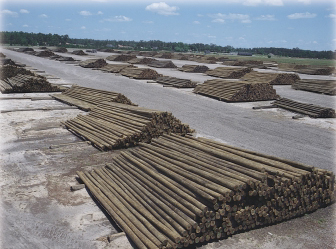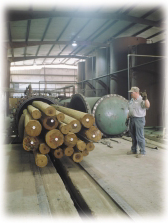The recently announced move of treated wood away from CCA to newer preservatives applies only to certain applications – and utility poles are not one of them.
On February 12, 2002, the EPA announced a voluntary decision by industry to move nonindustrial use of treated lumber products away from pressure-treated wood that contains chromated copper arsenate (CCA) preservative in favor of new alternative wood preservatives. The applications involved include decking, playsets, and residential projects. The decision does not affect CCA-treated poles, piling, or other industrial products.
“Many visitors to our booth thought CCA was banned for utility poles,” said Grady Brafford, Business Manager for Industrial Chemicals, Arch Wood Protection, after the Tech Advantage Show. “They had heard parts of the story, and were afraid that they would no longer be able to buy CCA-treated poles. That is not a cause for concern; CCA poles will continue to be produced and installed.”
CCA is a leading preservative among buyers of pressure-treated wood poles. Approximately 40% of wood utility poles are protected against termites and rot by CCA. Pentachlorophenol is used in about 50%, with creosote being the preservative of choice in the remaining 10%. All are impregnated into the wood by a pressure process performed at wood treating plants. Brafford added, “Arch Wood Protection manufactures both CCA and copper azole, one of the new-generation preservatives. We will have to increase our production of copper azole to meet demands of the non-industrial market, but we plan to continue producing CCA for pole treatment.”
CCA was invented in 1933. Its early use was for poles. Bell Telephone Company began ground testing in 1934. In 1938, Bell bought the U.S. patent rights and treated 300 full-size experimental poles. Commercial use of the preservative increased, albeit slowly, until the 1970s when homeowner use caused sales of CCA-treated wood to jump dramatically.
CCA poles also gained popularity as new formulations and favorable economics prompted utility purchasers to choose this waterborne treatment more frequently. The trend toward CCAtreated poles is likely to continue. Rather than going away, the production of CCA poles is expected to increase in the years ahead.
Part of the reason for this ongoing demand involves the features of a CCA-treated pole, and part is the incorporation of additives to the basic formulation.
Clean and Fixed
In neighborhood settings, the clean surface of CCA poles is often a deciding factor. CCA poles are non-staining.
Furthermore, since CCA bonds with wood in a chemical reaction called “fixation.” As a result, groundline treatment is not necessary for aging poles and there is no need to rotate poles during extended storage periods.
The CCA treatment is also low in conductivity, low in corrosivity, and does not impair bending characteristics of the wood – all beneficial characteristics.
However, pressure treatment with CCA can leave the pole surface somewhat brash. Even though the increased use of bucket trucks has reduced the need to climb poles, gaff penetration continues to be a concern on some systems.
Enter Oil Emulsion
To overcome this objection, some pole producers offer a secondary treatment called ET®, which injects a refined hydrocarbon oil emulsion in the outer layer of the pole following treatment with CCA. The viscous oil additive serves as a lubricant, making the pole easier to climb and work on, without affecting the preservative properties of the CCA treatment.
These RUS-approved poles have the longevity of regular CCA poles plus, because of the oil in the shell, they are easier to climb and to saw, drill, and nail. Nevertheless, they can be touched and handled without special safety precautions.
Economical Climbability
To overcome this objection, some pole producers offer a secondary treatment called ET®, which injects a refined hydrocarbon oil emulsion in the outer layer of the pole following treatment with CCA. The viscous oil additive serves as a lubricant, making the pole easier to climb and work on, without affecting the preservative properties of the CCA treatment.
The built-in water repellent reduces the impacts of weathering on the wood by slowing down the absorption and release of moisture. It has been found that the slow release of moisture creates greater pliability in the shell of a pole, making it easier to climb.
Warranties as Well as Chemicals
Not all of the enhancements to CCA poles have been due to chemical advances. Some treating companies now offer extended warranties against damage from termites and decay fungi.
The warranty resulted from marketplace claims that, in the minds of wood preserving operations, disparaged the lifetime of a wood pole. In order to counteract such talk, some companies now offer a 50-year warranty against wood-destroying organisms.
North American Wood Pole Coalition
The warranty is one way that the preservation industry has upheld the long tradition of wood poles. Another example of the industry’s defense against the incursion of alternative materials has been the formation of the North American Wood Pole Coalition.
Established in 1998, the NAWPC was formed to correct some misperceptions about wood poles and counteract some statements attributed to competitive products. The Coalition joined together the American Wood Preservers Institute, Canadian Institute of Treated Wood, Southern Pressure Treaters Association, Western Red Cedar Pole Association, and Western Wood Preservers Institute in an effort to promote wood poles, publish factual bulletins, and defend the interests of wood poles in technical organizations.
Currently serving as communications chairman for the group is Dennis Hayward of WWPI. He says, "The wood pole has been key to the delivery of power and communications so essential to the development of the high quality of life we enjoy in North America. The modern wood pole maintains all of the environmental, economic, and engineering benefits which have made it the preferred choice for over a century."
The desirable properties of a wood pole are a combination of the natural features of wood and the benefits of pressure treatment. For this reason, the Coalition adopted the slogan, “Engineered by Nature, Enhanced by Technology.”
NAWPC has published one brochure (“Ten Features Often Overlooked about the Extraordinary Wood Pole”) and several technical bulletins. Among these bulletins are studies on wood materials as a means to reduce greenhouse gases, raptor electrocutions as a function of pole types, environmental impacts of wood poles, working load comparisons in Class C line construction, a discussion of "wood equivalent" poles, and case histories of purchasing decisions. This literature is available from NAWPC members or by visiting www.preservedwood.com/pole/pole.html.
Nature’s Engineering
Some of the influence of nature is obvious in a wood pole. Wood is a naturally renewable resource. Sunlight and soil nutrients do most of the work in creating a pole, so energy requirements for pole production are minimal. And trees have a natural taper -- an efficient profile for a pole as well as for a tree.
Other examples of nature’s intricate engineering are more subtle, occurring at a microscopic level. For instance, the walls of a wood cell are layered. There is a primary wall on the outside with several secondary walls beneath. The walls are reinforced by natural microfibers running in different directions in each layer. The thickness of each layer and the variation in the fibril angles affect the strength, stiffness, and resilience of the pole. If there were no fibers or if they were all oriented in the same direction, the strength of the pole would be considerably less. Nature has done some magnificent engineering.
The inherent properties of wood are enhanced by modern forestry and preservation technologies. The species of trees that become poles are grown in managed timberlands to maximize their desirable characteristics. Through the pressure treating process, the wood becomes resistant to wood-destroying organisms and the useful life of the pole is extended many times.
Wood poles, treated with preservative, assisted the spread of civilization by carrying electricity and communications over long distances. From supporting telegraph wires to fiber optic cables, treated poles have served people effectively for a century, and will continue providing reliable service in the years ahead.
On February 12, 2002, the EPA announced a voluntary decision by industry to move nonindustrial use of treated lumber products away from pressure-treated wood that contains chromated copper arsenate (CCA) preservative in favor of new alternative wood preservatives. The applications involved include decking, playsets, and residential projects. The decision does not affect CCA-treated poles, piling, or other industrial products.
“Many visitors to our booth thought CCA was banned for utility poles,” said Grady Brafford, Business Manager for Industrial Chemicals, Arch Wood Protection, after the Tech Advantage Show. “They had heard parts of the story, and were afraid that they would no longer be able to buy CCA-treated poles. That is not a cause for concern; CCA poles will continue to be produced and installed.”
CCA is a leading preservative among buyers of pressure-treated wood poles. Approximately 40% of wood utility poles are protected against termites and rot by CCA. Pentachlorophenol is used in about 50%, with creosote being the preservative of choice in the remaining 10%. All are impregnated into the wood by a pressure process performed at wood treating plants. Brafford added, “Arch Wood Protection manufactures both CCA and copper azole, one of the new-generation preservatives. We will have to increase our production of copper azole to meet demands of the non-industrial market, but we plan to continue producing CCA for pole treatment.”
CCA was invented in 1933. Its early use was for poles. Bell Telephone Company began ground testing in 1934. In 1938, Bell bought the U.S. patent rights and treated 300 full-size experimental poles. Commercial use of the preservative increased, albeit slowly, until the 1970s when homeowner use caused sales of CCA-treated wood to jump dramatically.
CCA poles also gained popularity as new formulations and favorable economics prompted utility purchasers to choose this waterborne treatment more frequently. The trend toward CCAtreated poles is likely to continue. Rather than going away, the production of CCA poles is expected to increase in the years ahead.
Part of the reason for this ongoing demand involves the features of a CCA-treated pole, and part is the incorporation of additives to the basic formulation.

Clean and Fixed
In neighborhood settings, the clean surface of CCA poles is often a deciding factor. CCA poles are non-staining.
Furthermore, since CCA bonds with wood in a chemical reaction called “fixation.” As a result, groundline treatment is not necessary for aging poles and there is no need to rotate poles during extended storage periods.
The CCA treatment is also low in conductivity, low in corrosivity, and does not impair bending characteristics of the wood – all beneficial characteristics.
However, pressure treatment with CCA can leave the pole surface somewhat brash. Even though the increased use of bucket trucks has reduced the need to climb poles, gaff penetration continues to be a concern on some systems.
Enter Oil Emulsion
To overcome this objection, some pole producers offer a secondary treatment called ET®, which injects a refined hydrocarbon oil emulsion in the outer layer of the pole following treatment with CCA. The viscous oil additive serves as a lubricant, making the pole easier to climb and work on, without affecting the preservative properties of the CCA treatment.
These RUS-approved poles have the longevity of regular CCA poles plus, because of the oil in the shell, they are easier to climb and to saw, drill, and nail. Nevertheless, they can be touched and handled without special safety precautions.

Economical Climbability
To overcome this objection, some pole producers offer a secondary treatment called ET®, which injects a refined hydrocarbon oil emulsion in the outer layer of the pole following treatment with CCA. The viscous oil additive serves as a lubricant, making the pole easier to climb and work on, without affecting the preservative properties of the CCA treatment.
The built-in water repellent reduces the impacts of weathering on the wood by slowing down the absorption and release of moisture. It has been found that the slow release of moisture creates greater pliability in the shell of a pole, making it easier to climb.
Warranties as Well as Chemicals
Not all of the enhancements to CCA poles have been due to chemical advances. Some treating companies now offer extended warranties against damage from termites and decay fungi.
The warranty resulted from marketplace claims that, in the minds of wood preserving operations, disparaged the lifetime of a wood pole. In order to counteract such talk, some companies now offer a 50-year warranty against wood-destroying organisms.
North American Wood Pole Coalition
The warranty is one way that the preservation industry has upheld the long tradition of wood poles. Another example of the industry’s defense against the incursion of alternative materials has been the formation of the North American Wood Pole Coalition.
Established in 1998, the NAWPC was formed to correct some misperceptions about wood poles and counteract some statements attributed to competitive products. The Coalition joined together the American Wood Preservers Institute, Canadian Institute of Treated Wood, Southern Pressure Treaters Association, Western Red Cedar Pole Association, and Western Wood Preservers Institute in an effort to promote wood poles, publish factual bulletins, and defend the interests of wood poles in technical organizations.
Currently serving as communications chairman for the group is Dennis Hayward of WWPI. He says, "The wood pole has been key to the delivery of power and communications so essential to the development of the high quality of life we enjoy in North America. The modern wood pole maintains all of the environmental, economic, and engineering benefits which have made it the preferred choice for over a century."
The desirable properties of a wood pole are a combination of the natural features of wood and the benefits of pressure treatment. For this reason, the Coalition adopted the slogan, “Engineered by Nature, Enhanced by Technology.”
NAWPC has published one brochure (“Ten Features Often Overlooked about the Extraordinary Wood Pole”) and several technical bulletins. Among these bulletins are studies on wood materials as a means to reduce greenhouse gases, raptor electrocutions as a function of pole types, environmental impacts of wood poles, working load comparisons in Class C line construction, a discussion of "wood equivalent" poles, and case histories of purchasing decisions. This literature is available from NAWPC members or by visiting www.preservedwood.com/pole/pole.html.
Nature’s Engineering
Some of the influence of nature is obvious in a wood pole. Wood is a naturally renewable resource. Sunlight and soil nutrients do most of the work in creating a pole, so energy requirements for pole production are minimal. And trees have a natural taper -- an efficient profile for a pole as well as for a tree.
Other examples of nature’s intricate engineering are more subtle, occurring at a microscopic level. For instance, the walls of a wood cell are layered. There is a primary wall on the outside with several secondary walls beneath. The walls are reinforced by natural microfibers running in different directions in each layer. The thickness of each layer and the variation in the fibril angles affect the strength, stiffness, and resilience of the pole. If there were no fibers or if they were all oriented in the same direction, the strength of the pole would be considerably less. Nature has done some magnificent engineering.
The inherent properties of wood are enhanced by modern forestry and preservation technologies. The species of trees that become poles are grown in managed timberlands to maximize their desirable characteristics. Through the pressure treating process, the wood becomes resistant to wood-destroying organisms and the useful life of the pole is extended many times.
Wood poles, treated with preservative, assisted the spread of civilization by carrying electricity and communications over long distances. From supporting telegraph wires to fiber optic cables, treated poles have served people effectively for a century, and will continue providing reliable service in the years ahead.









